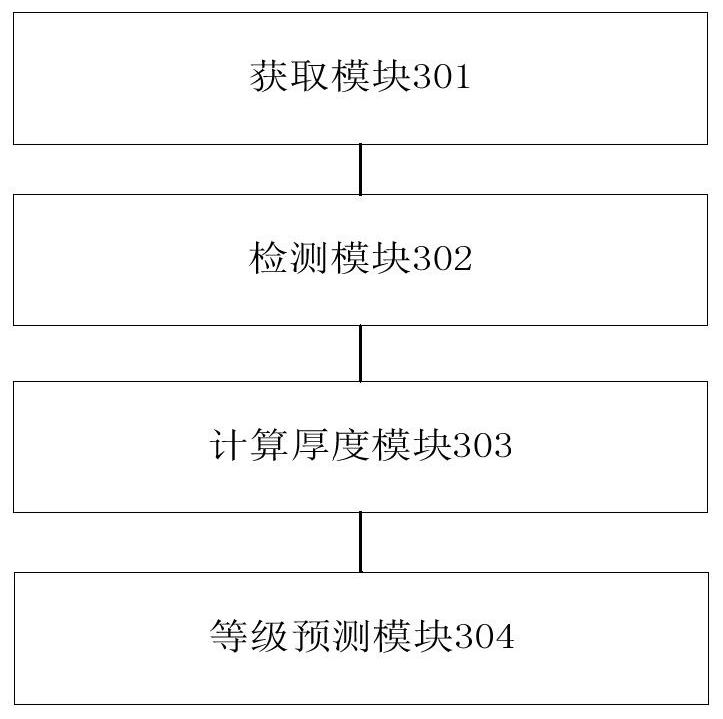OCT image-based Alzheimer's disease risk prediction method and system and medium
A prediction method and image technology, which is applied in image enhancement, image analysis, image data processing, etc., can solve problems such as difficult to meet the accuracy requirements of Alzheimer's disease risk prediction, low extraction accuracy, and complicated operation, and achieve Reduced overhead and receptive field, simple operation process, and high robustness
- Summary
- Abstract
- Description
- Claims
- Application Information
AI Technical Summary
Problems solved by technology
Method used
Image
Examples
Embodiment 1
[0068] This embodiment implements a method for predicting the risk of Alzheimer's disease based on OCT images, such as figure 1 shown, including the following steps:
[0069] S101. Input the fundus OCT image to the trained retinal segmentation model to obtain the segmentation mask of the retinal region;
[0070] S102. Input the fundus OCT image to the trained choroidal segmentation model to obtain a segmentation mask of the choroidal region;
[0071] S103, detecting the position of the fovea of the macula;
[0072] S104. Calculate the distance between the retinal segmentation mask at the fovea position and the upper and lower boundaries of the choroidal segmentation mask, and obtain the retinal thickness and choroidal thickness at the corresponding position;
[0073] S105. Input the omentum thickness, the choroid thickness, and the age and gender information of the person who took the fundus OCT image into the optimized multi-index Logistic regression model to obtain the A...
Embodiment 2
[0084] This embodiment implements a method for predicting the risk of Alzheimer's disease based on OCT images, including:
[0085] In the first step, the fundus OCT image is input to the trained retinal segmentation model to obtain the segmentation mask of the retinal region.
[0086] Specifically, the steps of training the retinal segmentation model are: obtaining OCT image training samples; configuring the encoding layer, bottleneck layer, decoding layer and classifier parameters of the retinal segmentation model; initializing the number of iterations of the retinal segmentation model; defining the A loss function of the retinal segmentation model; the OCT image training sample is input into the retinal segmentation model for training; when the training reaches a preset number of iterations, the training is terminated.
[0087] Obtain OCT image training samples; configure the encoding layer, bottleneck layer, decoding layer and classifier parameters; initialize the number of...
Embodiment 3
[0100] This embodiment implements a prediction system for the risk of Alzheimer's disease based on OCT images, such as figure 2 shown, including:
[0101] An obtaining module 301, configured to obtain a segmentation mask of the retinal region and a segmentation mask of the choroidal region;
[0102] A detection module 302, configured to detect the position of the fovea of the macula;
[0103] Calculating the thickness module 303, for calculating the distance between the upper and lower boundaries of the macular fovea position retinal segmentation mask and the choroidal segmentation mask, to obtain the retinal thickness and choroidal thickness at the corresponding position;
[0104] The grade prediction module 304 is used to input the omentum thickness, the choroid thickness and the age and gender information of the person who took the fundus OCT image into the optimized multi-index Logistic regression model to obtain the risk grade of Alzheimer's disease.
[0105] Wherein...
PUM
 Login to View More
Login to View More Abstract
Description
Claims
Application Information
 Login to View More
Login to View More - Generate Ideas
- Intellectual Property
- Life Sciences
- Materials
- Tech Scout
- Unparalleled Data Quality
- Higher Quality Content
- 60% Fewer Hallucinations
Browse by: Latest US Patents, China's latest patents, Technical Efficacy Thesaurus, Application Domain, Technology Topic, Popular Technical Reports.
© 2025 PatSnap. All rights reserved.Legal|Privacy policy|Modern Slavery Act Transparency Statement|Sitemap|About US| Contact US: help@patsnap.com



